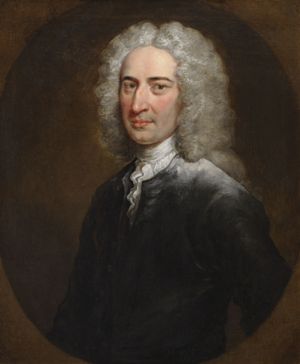Robert Smith, FRS
1689-1768. Master, Plumian Professor of Astronomy and Experimental Philosophy
 Robert Smith was the son of John Smith (d. 1710), Rector of Gate Burton, Lincolnshire, and his wife, Hannah, née Cotes. Robert was baptized on 16 October 1689 at Lea, near Gainsborough. His father, who had been educated at Trinity, and probably also at Oxford, sometimes tutored students in mathematics. Robert attended Mr Thomas's school in Leicester and was also tutored by his father before himself proceeding to Trinity, where he was admitted pensioner on 28 May 1708 and scholar on 13 May 1709. Having graduated BA in 1712, he obtained his degrees of MA in 1715, LLD in 1723, and DD in 1739. Elected to a College fellowship in 1714, he was a tutor from 1715 to 1734.
Robert Smith was the son of John Smith (d. 1710), Rector of Gate Burton, Lincolnshire, and his wife, Hannah, née Cotes. Robert was baptized on 16 October 1689 at Lea, near Gainsborough. His father, who had been educated at Trinity, and probably also at Oxford, sometimes tutored students in mathematics. Robert attended Mr Thomas's school in Leicester and was also tutored by his father before himself proceeding to Trinity, where he was admitted pensioner on 28 May 1708 and scholar on 13 May 1709. Having graduated BA in 1712, he obtained his degrees of MA in 1715, LLD in 1723, and DD in 1739. Elected to a College fellowship in 1714, he was a tutor from 1715 to 1734.
In 1716 he succeeded his cousin Roger Cotes to the Plumian professorship of astronomy and experimental philosophy, a post he relinquished in 1760, on being appointed Master of Mechanicks to George III. He acted as Vice-Chancellor of the University (1742-3) and was Master of Trinity from 1742 until his death in 1768. He was ordained at Norwich in 1738.
Smith's early career was moulded by his two patrons, Cotes and Richard Bentley (1662-1742). Soon after he entered Cambridge his interest in mathematics and natural philosophy was encouraged by Cotes, who appointed him as his assistant in the Plumian Observatory. When Smith received his fellowship Cotes warmly commended him as one of the few College tutors competent to teach both mathematics and recent developments in the physical sciences. His early reputation outside Cambridge and his first literary productions were due to his executorship of his cousin's will. In that capacity he edited two posthumous works by Cotes.
In College politics Smith invariably sided with Bentley, the Master, in his war of attrition against many of the Fellows, and after Bentley's death, succeeded him as Master. He seems to have been more conciliatory than his predecessor, but still engendered some ill feeling among the fellowship.
Smith provided encouragement and patronage to many younger scholars. But his most enduring influence was through his benefactions to Cambridge and particularly to Trinity. In 1758 he presented to the library a bust of Cotes by Peter Scheemakers, and paid for improvements to the observatory situated over the Great Gate. In his will he left £1750 to found the Smith's prizes, which were awarded annually to the two junior students who had made the greatest progress in mathematics and natural philosophy. These prizes were keenly sought after and became the badge of mathematical skill. Through these prizes Smith encouraged scientific studies at Cambridge, and many who later became major figures in British science scored their earliest successes in this stiff contest. Also through his will the Plumian bequest, out of which the professorship was financed, was augmented by £1750. He left South Sea stock worth £2000 to Trinity, which was used to finance a new combination room and a window in the library depicting George III celebrating Newton. Another beneficiary was Edward Walpole, a close friend from their student days, who also received £2000 in South Sea stock.
The successes of Isaac Newton in optics and mechanics dominated Smith's scientific career, and through his teaching and publications he helped to spread Newton's ideas, although he was not a direct recipient of Newton's patronage.
Smith's scientific reputation rests on two substantial works, Compleat System of Opticks and Harmonics, or, The Philosophy of Musical Sounds. Both books were highly regarded by many later eminent scientists. The Opticks, which was translated into both French and German, played a key role in the dissemination and systematization of Newton's theory of light.
Music was both Smith's pastime and his other main scientific interest. He was an accomplished performer on several instruments, particularly the violoncello, and possessed a ‘correct ear’. In his Harmonics he advocated the mean-tone temperament or method of tuning keyboard instruments. In the same work he contributed to the mathematical theory of music with an extended discussion of equal harmonic intervals. He directed the construction of the organ at the Foundling Hospital, which incorporated his system of alternative notes. Although his system found a champion in A.D. McClure in the 1940s, it has rarely been employed in keyboard instruments because of its complexity and the expense involved in constructing the instruments.
Smith never married but lived with his unmarried sister Elzimar (1683-1758) in the Master's Lodge at Trinity. He died at the lodge on 2 February 1768, and on 8 February he was buried in Trinity College Chapel, the funeral oration being delivered by Thomas Zouch.
DNB
Robert SmithShield located above the stalls on the north side of the Chapel |
|
|
|
PREVIOUS SHIELD |
|
NEXT SHIELD Edmund Stubbe |
| Shield Gallery | Sculpture Gallery |
Brass Gallery | Statue Gallery | Interment &Tombstone Gallery | War Memorial Gallery |
